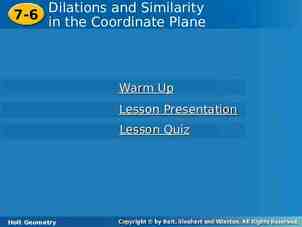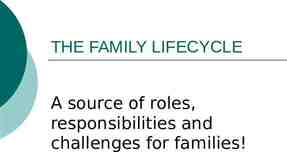Unit 8: Protein Synthesis 6A: Identify components of DNA, identify how
56 Slides3.53 MB
Unit 8: Protein Synthesis 6A: Identify components of DNA, identify how information for specifying the traits of an organism is carried in the DNA, and examine scientific explanations for the origin of DNA. I will identify that DNA is carried in chromosomes 6B: recognize that components that make up the genetic code are common to all organisms Given a template strand of DNA, I will complete the amino acid sequence.
Revisit prior knowledge What is the monomer for DNA? What are the three parts that make a nucleotide? What are the four nitrogen bases? Write the complementary base pairs to this DNA sequence CTG ACA TCG
Revisit prior knowledge What is the monomer for DNA? NUCLEOTIDE What are the three parts that make a nucleotide? Sugar, Phosphate, Nitrogen Base What are the four nitrogen bases? A, T, C, G Write the complementary base pairs to this DNA sequence CTG ACA TCG
Let’s Focus on Nitrogen Bases The SEQUENCE of the nitrogen bases is responsible for the coding of specific traits The SEQUENCE of the bases codes for traits by Coding for specific PROTEINS DNA provides instructions for proteins via its specific sequence of nitrogen bases
Main Idea DNA codes for RNA, which guides protein synthesis From Genes to Genetic expression (The central dogma of molecular biology) DNA RNA amino acid protein genetic expression Remember – the monomer of protein is amino acids
Roles of RNA and DNA 6 DNA is the MASTER PLAN RNA is the BLUEPRINT of the Master Plan
DNA vs RNA DNA SugarDeoxyribose Double stranded Nitrogen Bases: Adenine, Thymine, Gaunine, Cytosine Difference: Thymine RNA Sugar Ribose Single Stranded Nitrogen Bases: Adenine, Uracil, Guanine, Cytosine Difference: Uracil G, C, A, U
Think / Pair /Share Discuss the differences between DNA and RNA. Be ready to share out.
Ameoba Sisters: DNA v RNA https://youtu.be/0Elo-zX1k8M Answer the questions in your notes as you watch the video.
I am single stranded RNA I am found only in the nucleus of eukaryotic cells (except during mitosis when the nuclear membrane is dissolved) DNA I am a nucleic acid Both I am arranged as a double helix or “twisted ladder” DNA I have the sugar riboseRNA I have the sugar deoxyribose DNA I include the bases guanine cytosine and adenine Both I travel out of the nucleus to a ribosome RNA I have the base uracil RNA
RNA and Protein Synthesis DNA is a very large molecule. DNA cannot get out of the nucleus! But DNA codes for everything, so we need a messenger to take the information out of the nucleus!
RNA & Protein Synthesis DNA remains in the nucleus. To get DNA’s instructions translated into proteins, it must send its message to the ribosomes (in the cytoplasm) where proteins are There are 3 types of RNA involved in this process: made. mRNA: Messenger RNA tRNA: Transfer RNA rRNA: Ribosomal RNA
(mRNA) Messenger RNA – carries a copy of genetic information out of the nucleus to the ribosomes in the cytoplasm. (tRNA) Transfer RNA – carries specific amino acids to the ribosomes (rRNA) Ribosomal RNA – molecular component of a ribosome (the site of protein synthesis)
Transcription Translation 6C: explain the purpose and process of transcription and translation using models of DNA and RNA I will explain the purpose and process of transcription and translation using models
Moving the information from DNA to Proteins
Two Main Steps in Protein Synthesis 1. Transcription: Location: nucleus mRNA makes a copy of the DNA strand. LATER: mRNA takes the genetic message out of the nucleus.
Transcription
Think / Pair /Share Discuss the main things that happen during Transcription. Be ready to share out.
2. Translation: Location: Cytoplasm /Ribosomes tRNA carries amino acids to the mRNA at the site of a ribosome (rRNA) In RNA Adenine pairs with Uracil (A-U) Guanine pairs with Cytosine (G-C)
Translation
Think / Pair /Share Discuss the main things that happen during Translation. Be ready to share out.
Replica tion Cell DN A transcripti on Nucleus Protein mRN translati on Synthe A In Cytoplasm sis on Ribsomes
RNA Once a strand of RNA copies the genetic information from DNA, it leaves the nucleus. Each strand of RNA is many nucleotides long. Codon – three nitrogen bases in a row on mRNA. Anti-Codon – three nitrogen bases in a row on tRNA
mRNA Codes for Proteins in Triplets DNA TACGCACATTTACGTACGCGG Codo n Ribosome mRNA AUGCGUGUAAAUGCAUGCGCC Prote in MetArgValAsnAlaCysAla Block of 3 mRNA bases Codon
Circle a Codon and put a square around an Anti-Codon What biomolecule does the growing amino acid chain make?
What process is shown in X? What process is shown in Y? What process is shown in Z?
Try Transcribing DNA into RNA DNA Template Strand: ATG – GAC – TTG Messenger RNA Strand: Remember – RNA has Uracil instead of Thymine. C-G A-U HINT – anytime you would have written a “T,” write a “U” instead!
How do you know which amino acid is coded for? Use a codon chart! DNA CCT CTT TAC ACA CGG AGG GTA CGC TAT mRNA protein
Protein Protein Transcripti Transcripti on on Translati Translati on on
Protein Synthesis Amoeba Sisters Protein Synthesis https://youtu.be/h5mJbP23Buo Answer the following questions (next slide) OR do the back of the worksheet from yesterday.
Video Questions 1. DNA codes for traits (Proteins) 2. What does Protein Synthesis make? Proteins 3. Yes or No: Is all the DNA turned on all the time? 4. DNA is located in the Nucleus 5. What are the 2 step in Protein Synthesis? Transcription Translation 6. How many letters are read at a time? 3
Rememb er we use the Codon Chart only for mRNA DNA CCT CTT TAC ACA CGG AGG GTA CGC TAT TCT ATG ATT ACA CGG TTG CGA TCC ATA ATC mRNA protein
Protein Synthesis Mark through the tRNA. Only use mRNA for the correct Amino
Protein Synthesis Worksheet:
Unit 8: Protein Synthesis 6B: recognize that components that make up the genetic code are common to all organisms
The genetic code is universal ALL LIVING THINGS HAVE DNA as their genetic material ALL LIVING THINGS HAVE THE SAME GENETIC CODE
Genetic Engineering All living organisms have DNA, so scientists can add human DNA (or any other type of DNA) to bacterial DNA DNA codes for proteins, so scientists use the bacteria to quickly make human (or other organisms) proteins They can isolate those proteins and
Gene regulation 6D: recognize that gene expression is a regulated process I will recognize that gene expression is a regulated process
Gene regulation DNA- RNA- amino acid- protein- genetic expression The process above is regulated!
Gene regulation You have tens of thousands of genes in your genome. Does that mean your cells express all of those genes, all the time? Even an organism as simple as a bacterium must carefully regulate gene expression, ensuring that the right genes are expressed at the right time.
Gene regulation Genes can't control an organism on their own; they must interact with and respond to the organism's environment. Some genes are always "on," regardless of environmental conditions. They control the ability of DNA to replicate, express itself, and repair itself. These genes also control protein synthesis.
Mutations 6E: Identify and illustrate change in the DNA and the significance of these changes I will describe and model point mutations I will describe and model chromosomal mutations I will describe how mutations in the DNA sequence may or may not affect the amino acid in the protein Given a scenario, I will identify whether a change in DNA sequence will affect the amino acid sequence in a protein
Mutation Video http://www.youtube.com/watch?v GieZ3 pk9YVo
Mutations: Mutation can be harmful, helpful or neutral in their effect. Mutations create genetic variation
Syndactyly and dicephalia
White tigers are not a separate subspecies. They’re not Royal White Tigers. They’re not Snow Tigers. They’re not albinos. They’re simply tigers that are born with white fur. White fur is a very rare genetic mutation. It occurs in the wild possibly in as few as 1 in 10,000 wild tiger births.
Albinism Epidermodysplasia verruciformis (EV), also known as treeman syndrome.
Mutations are ANY changes in the genetic material. A mutation that occurs in the gametes will most likely be transferred to the offspring
Types of Gene Mutations Include: Point Mutations: Change of a single nucleotide. There’s two types: Include: 1. Substitution: Change in the nucleotide 2. Frameshift: insertion or of a single nucleotide deletion
Gene Mutations: Substitution Gene mutations result from changes in a single gene. A change in one base; aka point mutation. In substitution, one base replaces another. Substitutio n
Gene Mutations: (Frameshift) Insertion or Deletion In an insertion, an extra base is inserted into the base sequence. The loss of a single letter shows the effect of a deletion. Insertion Deletion Shifts right or left in reading frame Frameshift mutation
Mutation Type Normal Missense (substitution) Nonsense (substitution) Deletion (causing frameshift) Insertion (causing frameshift) Duplication Analogy Sentence Example of Associated Disease THE BIG FAT CAT ATE THE WET RAT THE BIZ FAT CAT ATE THE WET RAT Achondroplasia: improper development of cartilage on the ends of bones of arms and legs resulting in a form of dwarfism THE BIG RAT Muscular Dystrophy: progressive muscle disorder characterized by the progressive weakening of many muscles in the body THB IGF ATC ATA TET HEW ETR AT Cystic fibrosis: characterized by abnormally thick mucus in the lungs, intestines, and pancreas THE BIG ZFA TCA TAT ETH EWE TRA Crohn’s disease: chronic inflammation of the intestinal tract, producing frequent diarrhea, abdominal pain, nausea, fever, and weight loss THE BIG FAT FAT CAT ATE THE WET RAT Expanding mutation (tandem repeats) THE BIG FAT CAT ATE THE WET RAT Generation 1 THE BIG FAT CAT CAT CAT ATE THE WET RAT Generation 2 THE BIG FAT CAT CAT CAT CAT CAT CAT ATE THE WET RAT Generation 3 Charcot-Marie-Tooth disease (type 1A): damage to peripheral nerves leading to weakness and atrophy of muscles in hands and lower legs. Huntington’s disease: a progressive disease in which brain cells waste away, producing uncontrolled movements, emotional disturbances, and mental deterioration
Chromosome Mutations Five types exist: Deletion: removes a chromosome segment Inversion: reverses a segment within a chromosome Translocation: moves a segment from one chromosome to another, non-homologous one Duplication: repeats a segment Non-disjunction: chromosomes fails to separate properly during meiosis
Chromosome mutations create genetic variation
Lets review! Use your notes. What are the two types of point mutations? What happens in a frameshift mutation? Are mutations always bad? Why? Name the five types of chromosomal mutations. If a DNA sequence has a mutation, what will happen for the rest of protein synthesis? What is the monomer of a protein called?
Mutation Worksheet





























































